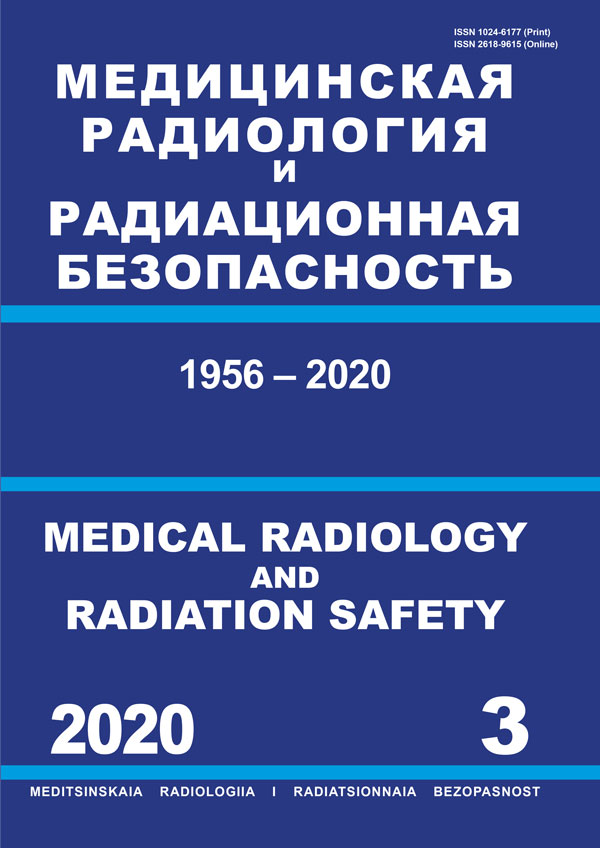CSCSTI 86.40
CSCSTI 87.33
Russian Classification of Professions by Education 14.02.02
Russian Library and Bibliographic Classification 201
Russian Library and Bibliographic Classification 511
BISAC MED080000 Radiology, Radiotherapy & Nuclear Medicine
BISAC SCI058000 Radiation
Purpose: The assess the contribution of modern activity of Research Institute of Atomic Reactors (JSC «SSC RIAR») in the formation of man-made risks for the population of Dimitrovgrad, Ulyanovsk region. Material and methods: The results of monitoring of the state of the environment, meteorological features of the area of JSC «SSC RIAR» location, data on the radiation and sanitary-epidemiological situation in Dimitrovgrad were studied and analyzed. The materials of the state reports, annual reports and analytical references of the Rospotrebnadzor, the Volga UGMS, Ulyanovskstat, the Ministry of Ecology and Nature Management of the Ulyanovsk Region and the Interregional Department № 172 of the FMBA of Russia, as well as the results of industrial and environmental monitoring provided directly by JSC “SSC RIAR” were used as the sources of the initial data. The work was carried out dispersion modeling of current annual gas and aerosol emissions to estimate the contribution of JSC « RIAR » in the formation of ambient city air pollution. The calculation of risks was carried out in accordance with the UNSCEAR methodology for the assessment of radiation risk and the Guidelines for the assessment of the effects of toxic and carcinogenic chemicals approved by the Ministry of Health of the Russian Federation. Results: The average annual dose rate for the population of Dimitrovgrad caused by current emissions of JSC «SSC RIAR» according to the results of conservative calculations is 0.9 µSv/year. The value of radiation risk for the population of the residential zone is at the level of 2.9∙10–8, while for the entire territory of Dimitrovgrad it is 5.4∙10–8. The resulting value of the radiation risk to the health of people living in a residential area of the city is more than 30 times lower than the level of acceptable risk (1∙10–6). The total value of chemical risk from all sources of air pollution in Dimitrovgrad is 1.3∙10–3. This risk level is in the range of unacceptable risk neither for the population nor for professional groups. Assessment of a carcinogenic risk from pollutants suggests the occurrence of malignant neoplasms as a negative effect. The total value of carcinogenic risk is 1.3∙10–4, which slightly exceeds the upper limit of the acceptable risk level for the population. Conclusion: The contribution of anthropogenic radiation factor to the overall risk structure is less than 0.003 %. The role of JSC “SSC RIAR” in the air pollution of the residential zone of the city is negligible and does not create toxic risks for the population of Dimitrovgrad. Thus the current activity of JSC “SSC RIAR” leads to negligible values of carcinogenic risks for the population of the area of the nuclear facility location.
JSC «SSC RIAR», radiation safety, radiation risk, chemical risk, the state of the environment
1. Onishchenko GG, et al. Principles of Risk Assessment for Health of the Population with Exposure to Chemical Substances, Polluting the Environment. Moscow. 2002. 408 p. (In Russ.).
2. Avaliani SL, et al. Environmental management based on risk analysis methodology. Tutorial. Moscow. 2006. 186 p. (In Russ.).
3. Anenberg SC, et al. Survey of Ambient Air Pollution Health Risk Assessment Tools. Risk Analysis. 2016;36(9):1718-36. Special Issue: Air Pollution Health Risks.
4. Environmental safety report. JSC “SRC RIAR”. 2017 Report. Dimitrovgrad. 89 p. (In Russ.).
5. Bogatov SA, Kiselev AA, Shvedov AM. Methodological approaches for the assessment of the radiation situation, the expected exposure and the effectiveness of the countermeasures at short-term release of radioactive substances into the atmosphere in the model «PROLOG» (P. 1). Preprint № IBRAE-2011-02. 2011. 40 p. (In Russ.).
6. United Nations Scientific Committee on the Effects of Atomic Radiation (UNSCEAR) 2006 Report. Annex A. Epidemiological Studies of Radiation and Cancer. New York: United Nations sales publication. 2008. 310 p.
7. IARC Monographs on the Evaluation of Carcinogenic Risks to Humans. Lyon, France. 2016. 454 p.
8. Guidelines for assessing the risk to public health when exposed to chemicals that pollute the environment P 2.1.10.1920-04. Moscow; 2004. 340 p. (In Russ.).
9. United States Environmental protection agency. Risk assessment guidance for superfund. Volume I: Human health evaluation manual (Part E, supplemental guidance for dermal risk assessment). Washington DC: U.S. EPA. 2004. 156 p.
10. The results of radiation hygienic certification in the subjects of the Russian Federation for 2016. Radiation hygienic passport of the Russian Federation. Moscow. 2017. 126 p. (In Russ.).
11. Romanovich IK, et al. Natural sources of ionizing radiation: radiation doses, radiation risks, preventive measures P.V. Ramzayev NIIRG. Ed. Onishchenko GG, Popova AYu. St. Petersburg. 2018. 432 p. (In Russ.).
12. Letter of Ulyanovskstat No. 64 / OG dated July 19, 2018 signed by the Acting Director O.V. Karavashkina on providing information on statistics on the form 2-TP with an electronic application. (In Russ.).
13. The state of air pollution in the territory of the Volga UGMS activities. Yearbook for 2017. Moscow. 2018. (In Russ.).
14. Database on social and hygienic monitoring of the Interregional Management No. 172 of the FMBA of Russia. (In Russ.).
15. Radiation safety standards NRB-99/2009. Hygienic standards SP 2.6.1.2523-09. Moscow. 2009. 100 p. (In Russ.).
16. Rakhmanin YuA, et al. Actual problems of environmental factors risk assessment on human health and ways to improve it. Health Risk Analysis. 2015;2(10):24-34. (In Russ.).





